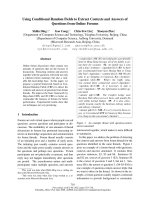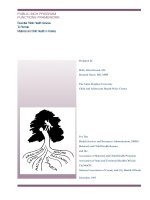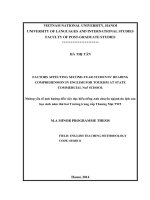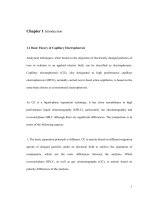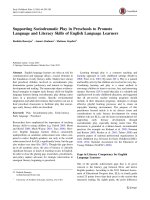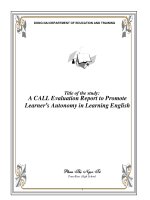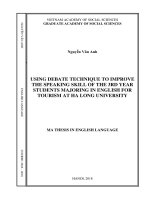Using simple english songs to promote confidence and motivation toward learning english for pupils at a primary school
Bạn đang xem bản rút gọn của tài liệu. Xem và tải ngay bản đầy đủ của tài liệu tại đây (1.93 MB, 85 trang )
VIETNAM NATIONAL UNIVERSITY, HANOI
UNIVERSITY OF LANGUAGES AND INTERNATIONAL STUDIES
FACULTY OF POST-GRADUATE STUDIES
*********
NGUYỄN THỊ THUÝ NGA
USING SIMPLE ENGLISH SONGS TO PROMOTE CONFIDENCE
AND MOTIVATION TOWARD LEARNING ENGLISH FOR PUPILS
AT A PRIMARY SCHOOL IN HANOI
(Sử dụng các bài hát tiếng Anh đơn giản để thúc đẩy sự tự tin
và động lực học tiếng Anh cho học sinh tại trường tiểu học ở Hà Nội)
M. A. MINOR PROGRAMME THESIS
Field
: English Teaching Methodology
Code
: 8140231.01
HANOI – 2018
VIETNAM NATIONAL UNIVERSITY, HANOI
UNIVERSITY OF LANGUAGES AND INTERNATIONAL STUDIES
FACULTY OF POST-GRADUATE STUDIES
*********
NGUYỄN THỊ THUÝ NGA
USING SIMPLE ENGLISH SONGS TO PROMOTE CONFIDENCE
AND MOTIVATION TOWARD LEARNING ENGLISH FOR PUPILS
AT A PRIMARY SCHOOL IN HANOI
(Sử dụng các bài hát tiếng Anh đơn giản để thúc đẩy sự tự tin
và động lực học tiếng Anh cho học sinh tại trường tiểu học ở Hà Nội)
M. A. MINOR PROGRAMME THESIS
Field
: English Teaching Methodology
Code
: 8140231.01
Supervisor : Assoc. Prof. Dr. Hồ Ngọc Trung
HANOI - 2018
DECLARATION
I, the undersigned, declare that this thesis is the result of my
own researcher and has not been submitted to any other university
or institution partially or wholly. Except where the reference is
indicated, no other person’s work has been used without
acknowledgement in text of the thesis.
Hanoi, 2018
M. A. Student,
Nguyễn Thị Thúy Nga
Approved by Supervisor
Assoc. Prof. Dr. Hồ Ngọc Trung
iii
ACKNOWLEDGEMENTS
This thesis could not have been completed without the help and
support from a number of people.
First and foremost, I would like to send my sincere thanks to my
supervisors, Assoc. Prof. Dr. Hồ Ngọc Trung for his enthusiastic guidance,
insightful comments, and valuable support throughout my research. He
consistently allowed this paper to be my own work, but steered me in the right
the direction whenever I thought I needed it.
I also would like to thank all of the lecturers of the Faculty of PostGraduate Studies, Vietnam National University, Ha Noi for their useful
lectures and materials which are of great value to my thesis.
I would like to extend my special thanks to all of my colleagues and
the students at Phuong Canh Primary School for their useful support.
Finally, I must express my very profound gratitude to my family for
providing me with unfailing support and continuous encouragement
throughout my years of study and through the process of researching and
writing this thesis. This accomplishment would not have been possible
without them.
iv
LIST OF TABLES
Table 3.1: Demographic gender distribution ................................................. 26
Table 3.2: Contents of songs .......................................................................... 27
Table 4.1: The score of the Pre-test ............................................................... 32
Table 4.2: The syllabus of action ................................................................... 34
Table 4.3: The score of the Post-test .............................................................. 36
Table 4.4: Pre-test and post-test scores .......................................................... 36
Table 4.5: The mean scores of the items about language acquisition ............ 38
Table 4.6: T- test of gender difference in language acquisition .................... 38
Table 4.7: Gender difference about Item 15 .................................................. 39
Table 4.8: The mean scores of the items about learning motivation ............. 40
Table 4.9: T- test of gender difference in learning motivation ...................... 41
v
ABSTRACT
The aim of this study is to look at the importance of using songs
within the English classroom. This study can determine if using songs within
the English classroom can promote language acquisition, and if using songs
within the room can encourage the kids to learn a foreign language. The study
was conducted at Phuong Canh Primary School in Hanoi, with one hundred
and thirty-one students of grade three participating in the study. The
participants were examined through a pre-test, a post-test, a questionnaire and
through classroom observations and field notes. The pre-test and post-test
were designed and developed in step with the choice of songs that had been
chosen to show vocabulary, structure and practice listening skill by the
investigator. The instruments were analyzed using the statistical package
(SPSS 20.0). The results of the pre-test confirmed that the students had not
acquired the target vocabulary, structure beforehand. The post-test results
confirmed the rise of scores thus confirming language acquisition of the target
vocabulary and structure that were taught using the choice of songs. The
results of the questionnaire discovered that once songs were wont to teach the
target vocabulary in the English language classroom the students were
motivated towards the lesson. The results of the classroom observations and
field notes showed that once songs are integrated into the foreign language
room they promote the students’ confidence in learning the English language
and also their native language, that is Vietnamese.
Keywords: songs, confidence, motivation, foreign language learning.
vi
TABLE OF CONTENTS
DECLARATION ........................................................................................ iii
ACKNOWLEDGEMENTS ........................................................................ iv
LIST OF TABLES ...................................................................................... v
ABSTRACT ................................................................................................ vi
TABLE OF CONTENTS ............................................................................ vii
CHAPTER 1: INTRODUCTION ............................................................... 1
1.1 Rationale................................................................................................ 1
1.2 Aims and objectives of the study .......................................................... 1
1.3 Research Questions ............................................................................... 2
1.4 Scope of the study ................................................................................. 2
1.5 Significance of the study ....................................................................... 3
1.6 Research method ................................................................................... 4
1.7 Structure of the thesis ............................................................................ 4
CHAPTER 2: LITERATURE REVIEW .................................................... 6
2.1 Songs in learning language ................................................................... 6
2.1.1 Definition of song ............................................................................... 6
2.1.2 Using songs in foreign language acquisition.............................................. 8
2.1.3 Advantages of using songs in teaching and learning language ................ 9
2.1.4 Strategies with songs and music on language acquisition ........................ 11
2.2 Motivation ............................................................................................. 12
2.2.1 Definition of motivation ................................................................................ 12
2.2.2 Motivation in language learning.................................................................. 14
2.2.3 Roles of motivation in language learning ................................................... 15
2.2.4 Strategies for motivating students in the classroom ................................... 16
2.3 Confidence ............................................................................................ 17
2.3.1 Definition of confidence ................................................................................ 17
vii
2.3.2 The Importance of students’ confidence in language learning ................. 18
2.4 Summary ............................................................................................... 19
CHAPTER 3: METHODOLOGY .............................................................. 20
3.1 Restatement of the objectives and research questions .......................... 20
3.2 Research design ..................................................................................... 21
3.3 Research procedures ......................................................................................... 22
3.4 The setting of the study .................................................................................... 24
3.5 Participants of the study ................................................................................... 25
3.6 Research Instruments ............................................................................ 26
3.6.1 Songs ............................................................................................................... 26
3.6.2 Pre-test and Post-test .................................................................................... 28
3.6.3 Questionnaire ................................................................................................. 28
3.6.4 Classroom Observations and Field Notes................................................... 29
3.7 Data collection....................................................................................... 30
3.8 Method of Data Analysis ...................................................................... 31
3.9 Summary ............................................................................................... 31
CHAPTER 4: DATA ANALYSIS AND DISCUSSION ........................... 32
4.1 Analysis of the Pre-test ......................................................................... 32
4.2 Analysis of the Action Process ............................................................. 33
4.2.1 Planning.......................................................................................................... 33
4.2.2 Processing ...................................................................................................... 35
4.2.3 Reflection ........................................................................................................ 35
4.3 The Analysis of the Questionnaires ...................................................... 37
4.4 Analysis of the Classroom observation and field notes findings .......... 42
4.5 Discussion.......................................................................................................... 44
4.5.1 To what extent does the use of songs influence language acquisition?.... 44
viii
4.5.2 To what extent do songs affect students’ motivation when learning
English? ...................................................................................................... 45
4.5.3 Does the use of songs promote confidence toward learning English for
students? ..................................................................................................... 45
4.6 Summary ............................................................................................... 45
CHAPTER 5: CONCLUSION.................................................................... 47
5.1 Conclusion............................................................................................. 47
5.2 Limitations ............................................................................................ 48
5.3 Suggestions for further studies .............................................................. 48
REFERENCES ............................................................................................ I
APPENDICES ............................................................................................. VI
Appendix A: Questionnaire......................................................................... VI
Appendix B: VIIQuestionnaire (Vietnamese Translation) ......................... VII
Appendix C: Pre-test & Post-test ................................................................ IX
Appendix D: The Sample of lesson plan .................................................... XI
Appendix E: Sample of Student’s Pre-test.................................................. XV
Appendix F: Sample of Student’s Post-test ................................................ XVII
Appendix G: Sample of Student’s questionnaire ........................................ XIX
Appendix H: Checklist for teacher’s observation ....................................... XX
Appendix I: Song lyrics .............................................................................. XXI
ix
CHAPTER 1: INTRODUCTION
1.1. Rationale
In today’s global world, the importance of English cannot be denied and
ignored since English is the most common language spoken everywhere. With
the help of developing technology, English has been playing a major role in
many sectors including medicine, engineering, and education, in my opinion,
is the most important arena where English is needed. Particularly, as a
developing country, Vietnam needs to make use of this world wide spoken
language in order to improve its international power. In many public school’s
teachers cannot rely on good resources for teaching and it is a barrier that in
most cases does not let students learn English in an interactive and pleasant
way. For this reason, searching for better methodologies to instruct this
subject and helping students enhance their English is important. One of the
major weaknesses of my students is the lack of confidence to talk. On the
other hand, students do not acquire a second language the same way that they
acquire their first language. They do not have a real interaction with that
language in their day-to-day lives or the possibility to practice it outside of the
classroom and that makes the acquisition even more difficult. Using simple
English songs seems to be one of the useful solutions to promote confidence
and motivation toward learning English for pupils at Phuong Canh Primary
School, Nam Tu Liem District in Hanoi, Vietnam. The students often find
problem with learning English when they speak, read, listen and write to
English.
1.2. Aims and objectives of the study
This study is aimed at implementing songs as a resource to develop
communicative abilities properly in a foreign language, providing students
1
with the opportunity to talk with confidence and giving teachers the chance to
teach English in a fun way. In order to achieve the aim, the thesis is expected
to fulfill the following objectives:
Investigating the extent to which songs influence language
acquisition;
Exploring the extent to which songs affect students’ motivation
when learning English;
Examining whether the use of songs in the English language
classroom promotes confidence for students.
1.3. Research Questions
For the above objectives, the following research questions are
addressed:
1. To what extent does the use of songs influence language
acquisition?
2. To what extent do songs affect students’ motivation when learning
English?
3. Does the use of songs promote confidence toward learning English
for students?
1.4 Scope of the study
The study was to investigate whether using simple English songs in
the language classroom increased primary students’ language acquisition,
affected their motivation when using the language and promoted their
confidence of the target language. The research was conducted at Phuong
Canh Primary School which is located in Nam Tu Liem District in Hanoi. In
total one hundred and thirty-one primary participants participated in the study.
All of the students are in the third grade. They were from three classes, named
2
as Class A, Class B and Class C. The research instruments include a Pre-test,
a Post-test, a questionnaire, classroom observations and field notes employed
to provide the relevant information.
1.5 Significance of the study
The findings of the study contribute to the development of existing
theories about effects of using songs in teaching foreign languages. Through
listening to and performing songs, students are introduced to grammar,
diction, idioms and dialects that increase comprehension and widen their
understanding of how English is used. Using songs in teaching English,
especially as a second language to non-native speakers, is a great way to
create a friendly, comfortable atmosphere for students to learn.
The result of this study affirmed once more that music underlies
language acquisition. Music can be used to stimulate language acquisition.
All elements of music can be exploited to elicit ideas in writing. The context,
lyrics and rhythm furnished in the songs can stimulate learners’ imagination.
These factors are recommended due to the fact writing itself is an act of
imagination. Using songs in the classroom has both linguistic and cognitive
value for strengthening English language acquisition. So, the use of songs in
the language classrooms can help to strengthen the language acquisition of the
primary children.
Additionally, oral language is an interactive and social process, and
music is a natural way for children to journey rich language in a pleasurable
way. Music has always been a way for young students to remember stories
and research about the world around them. Using songs as a stimulus can
impact one's thoughts and make information easier to remember. Music also
creates an environment that is conducive to learning. Songs can supply the
3
students with a motivational, exciting environment and can also make the
primary students feel confident when using the language.
Practically, the findings may provide useful guidelines for the teachers
in Phuong Canh Primary School in developing English materials as well as
better improving English teaching and learning quality. The results of the
study might lead to measures in solving the students’ language learning
problem as revealed in their response, which may assist these students to
achieve an adequate level of English.
1.6 Research method
To achieve the objectives, this study used both qualitative and
quantitative methods. Qualitative research is particularly concerned in how
things arise and principally in the perspectives of the subjects of a study
(Fraenkel & Wallen, 2009: 435). So, qualitative research helps to collect the
information that comes from the viewpoint of the subject of a study that was
analyzed to come to the conclusion.
Quantitative research helped the researcher gather data in a numerical
form which can be put into categories, or in rank order, or measured in units
of measurement. This type of data can be used to construct graphs and tables
of raw data.
The data was collected via a pre-test and post-test, interview questions,
a questionnaire and through classroom observations and field notes.
1.7 Structure of the thesis
The study is organized into five chapters. Chapter I deals with the
Introduction. This includes Background, Aim and objectives of the study,
Research questions, Scope of the study, Significance of the study, Research
method and Structure of the study.
4
Chapter II includes review of the literature related to songs in the
classroom, motivation, confidence in language learning and theories about
action research.
Chapter III presents objectives of the study, research design,
procedures of action research, context and participants of the study, research
instruments, data collection and method of data analysis.
Chapter IV presents data analysis which includes analysis of pre-test,
post-test, analysis of the action process, the analysis of the questionnaire and
analysis of the classroom observation and field note, followed by discussion.
Chapter V is the conclusion and limitation of the study.
5
CHAPTER 2: LITERATURE REVIEW
In this study the researcher convinces that songs can offer new ways to
improve student’s skill in learning English, carrying pupils into pleasure
activities without reduce discipline of learn and promoting pupils’ confidence
in using English as a second language.
2.1 Songs in learning language
2.1.1. Definition of song
Oxford Learner’s Pocket Dictionary stated that songs are short pieces
of music with words that you sing. Songs are works of art which can be
enjoyed by anyone. Songs are musical compositions. Songs contain vocal
parts that are performed with the human voice and generally features words
(lyrics), common accompanied by other musical instruments.
The songs for children contain simple vocabulary. Sometimes about
objects around, so it makes students familiar English word. Songs also can be
used to teach English grammar, such as article. By using song students can
enjoy the lesson, because song is considered as a bridge of pleasure learning.
It can help students to enjoy the material and easy to memorize the material.
Applying songs in English language learning is not a new idea; writers
have long been arguing for use of song lyrics in a context for both their value
as exponents of linguistic features and for the motivational interest they
produce in language students (Bartle: 1962, Richards: 1969, Jolly: 1975).
Songs can include lots of repetition and might provide enjoyable
opportunities to work on pronunciation. They could integrate well with
different classroom activities such as stories, games, dance, etc. But they can
also combine with some paper-based activities, such as picture, color, or
number dictation. The use of songs can generate strong motivation to
6
participate in classroom activities. Songs also give a chance to develop
automaticity which is the main cognitive reason for using songs in the
classroom (Schlepp 2001). Singing songs could have useful effects no longer
on the students’ enjoyment however additionally on their motivation, and it
can consequently be a fun way to channel their desires to move around and
make a noise. Besides, it may be useful for varying the pace and power stages
of the class and it can be used at any point in the class either to calm down or
to stimulate the children. It also permits the teacher a whole class grouping,
apart from the regular one. Even those who are not ready to sing can join in
with certain actions.
As a matter of fact, affective reasons are connected with Krashen’s
Affective Filter Hypothesis. In short, it gives an explanation why some
learners learn and others do not. The crucial thing is that students need to
develop a positive attitude towards learning (Eken 1996: 46). Krashen (1982:
45) has it that: “for effective learning the affective filter must be weak. A
weak affective filter means that a positive attitude to learning is present.”
Hence teachers’ task is to provide a positive atmosphere favorable for
learning. In this aspect music and songs may be one of the methods for
obtaining weak affective filter (Eken 1996: 46).
Eken (1996: 46) enumerates eight reasons for the use of songs in a
language classroom. Firstly, a song can be used to present a topic, new
vocabulary or a language point. Then, it can additionally be used as a practice
of lexis. Beyond question, songs can be used as a material for extensive and
intensive listening. Some instructors can also use them to focus on common
learner mistakes in a more indirect way. Not to say that songs are a perfect
source for stimulating discussions about feelings and attitudes. Learners may
talk over with another in pairs or in small groups what happened in the song
7
and then share their opinions with the rest of students. Additionally, songs
may set up a relaxed classroom environment and make contribution to fun
and range in language teaching. Finally, songs can be said to encourage the
use of creativeness and creativity at some stage in foreign language training.
And there are some reasons using songs in teaching English as a
foreign language for young learners in the classroom; they are:
Songs are memorable, and so enable students to remember the
language.
Students can be great fun. And the biggest factor that makes
them fun is using songs because using songs gave big motivation for students
especially young learners.
Songs provide an achievable challenge for all levels of learner in
mixed ability classes, by letting some students just show their understanding by
doing the actions while others can sing along or even improvise their own words.
Songs can be used at whatever stage.
They allow for lots of repetition of the language without kids
getting bored (as long as you add variations). Variations to keep it interesting
include doing the song louder and quieter, slower and faster.
2.1.2 Using songs in foreign language acquisition
Language learning requires complex cognitive skills. Song lyrics
encourage and increase cognitive learning by integrating multiple dimensions
that will engage students of varying abilities. Students retain more knowledge
when reinforced through songs and the integration of lyrics and language. By
blending education and entertainment, approaches to learning are evolved and
reinforced. Music infused throughout learning creates authentic interactions
that are connected, flexible and often collaborative. Additionally, enjoyment
8
and entertainment are realized as students incorporate music and song into
language acquisition.
Using songs in the classroom has both linguistic and cognitive value
for strengthening English language acquisition. The four major language
acquisition
skills
that
are
targeted
include
grammar,
vocabulary,
pronunciation and listening, however learning a language to a high degree
requires communicative competence as well (Baker, T. (2013). The
relationship of theory to the constructs of language acquisition requires
challenging and interesting tasks that will pique the interest of the learner and
lead to retention of knowledge. Much has been written regarding English
language learner pedagogy and strategies for cognitive learning, but whatever
best practices are employed, they need to be based on realistic expectations
and hold the interest of the students. For example, idioms or idiomatic
expressions, which are words or phrases that have a hidden and figurative
meaning conventionally understood by native speakers, can be taught through
songs and humor. Karaoke can be used effectively with students and the
subtitles reinforce the language learning. Singing feels much less threatening
to many who are learning a new language. Catchy tunes that resonate with
students of all ages are beneficial in promoting lasting learning. For years,
people have tuned in to music on the radio featuring popular current songs
that shape cultures and worldviews. Simultaneously, they are strengthening
and reinforcing language skills through extensive and intensive listening.
2.1.3 Advantages of using songs in teaching and learning language
According to Richards & Rodgers (2008) songs can be used for a
number of purposes such as: to increase motivation and interest, to aid
acquisition of language in context, to improve listening skills and even
9
pronunciation through singing. In other words, songs can be considered a
valuable pedagogical tool.
According to McDermott and Hauser (2005: 29), music may be found
everywhere. Namely, we can hear it almost everywhere: while listening to the
radio, when watching television and on different family occasions, such as
birthday parties, wedding ceremonies, at a funeral, in restaurants, shops, cars,
and even in the streets. The repetition used in the song’s lyrics can help
learners remember vocabulary easily (Griffee 1992). It is much easier to learn
vocabulary in the context of the songs. Moreover, lyrics in songs have theme
lines, or story behind which enable learners to learn language in a meaningful
context. “Also, songs offer rich background and social and historical context
to language learning” (Griffee 1992: ix). Furthermore, music raises language
awareness. Advanced learners are encouraged to identify the language pattern
and the errors when they are exposed to lyrics which are grammatically
incorrect or inappropriate.
In generally, songs are beneficial for various reasons in English
classes; Griffee (1988) identified the following reasons:
Songs and music lower anxiety. If they are introduced in the
early years of language learning, songs and music tends to create enjoyable,
anxiety-free environment.
Songs are useful for teaching vocabulary.
Songs serve as an excellent listening material.
Songs can be used as supplemental texts in the end of the lesson,
on special occasions or as an additional component for vocabulary
development.
Songs and music can be used to support grammar presentation,
10
practice and revision.
Songs and music bring various cultures into the classroom.
2.1.4 Strategies with songs and music on language acquisition
We cannot deny that, as human beings, we have a special ear for
music. If we try teaching alphabets to a child, for example, we will realize
that the child picks them up faster and hence will memorize them better if we
sing them out for them. Songs are a form of language that uses tones and
rhythm and they are also the media of universal language for everybody.
Language and music are known to have similar communicative modes.
According to Peacock, “they are aurally and orally transmitted, they
both contain phonetic, syntactic and semantic components and they develop
early in life as social interactive media” (Peacock 1997: 51). Another
important reason is that songs make up a powerful means of teaching English
at all ages. We can use songs as a classroom activity in order to enrich our
students’ vocabulary or to improve their grammar and the different English
accents. Teaching songs in Primary Education to the students may be
beneficial for them both inside and outside the school. It also provides an
excellent opportunity to increase the skills of students in the area of foreign
language through the follow-up activities of writing, reading, or practicing the
skills taught in class.
To apply songs in the classroom, the teacher should also plan
application sequence of the songs. In applying songs, the writer offers two
procedures suggested by Ur and Wright and Haycraft.
(1) The procedure suggested by Ur and Wright (1993: 77-78) as follows:
Preparation: select a tape recording of a song so that you can sing it.
Prepare an overhead transparency (or a poster/ hand out) of the words of the song.
11
Procedure: first, play the song on a tape or sing it to yourself;
second, show the words of the song; third, ask the students to follow the
words; fourth, sing while you play it again.
(2) The procedure suggested by Haycraft (1983: 93), he suggested
some variations using songs recorded on tape as follows:
Play the tape as many times as necessary and ask questions.
Get the class to use line by following the tape.
Divide up the class and have a group, each singing a line. Reply
to the tape as often as necessary. Find out who has a good voice and try to get
solos. Bring out a student to conduct different combination until the song is
familiar.
Play and sing whenever you want to revise. It is good to play
songs at the beginning of class, while everyone is setting down.
In doing the study the writer will use both the procedure suggested by
Ur and Wright and Haycraft.
2.2 Motivation
Motivation is one among the foremost necessary factors that influence
language learners’ success or failure in learning the language.
2.2.1 Definition of motivation
There are many different definitions of motivation, especially in
language learning.
Cook (2000) defined motivation as the most important factor among
age, personality and motivation which affect the Second Language
Acquisition chiefly. It is also defined as "the choices people make as to what
12
experiences or goals they will approach or avoid and the degree of effort they
will exert in this respect" (Keller, 1983). Specifically, for language learning
motivation can be understood as learners’ orientation with regard to the goal
of learning a second language. Ellis (1994) considers motivation as the
exertion which learners contribute into learning a language learner as a result
of their need or desire to learn it. It would be argued that the nature of
motivation has the relationship with such elements as cognition, feelings and
emotions, and environment. Moreover, it will help delve deeper into the
grounds of motivation research. Light brown and Spade (1993) define
motivation in second language acquisition as "a complex phenomenon which
can be defined in terms of two factors: learners’ communicative needs and
their attitude towards the second language community". They assert that
learners will be motivated to acquire understanding in community when they
recognize the need to speak the second language in order to communicate or
to fulfill professional ambitions. This is what Gardner and Lambert (1972)
defined as integrative motivation and instrumental motivation. Specifically,
integrative motivation is the desire to participate in the activities of the target
language community and develop in their language (Gardner, 2001). And
instrumental motivation means the desire to acquire a foreign language to find
out employment or improve their self-cultivation or improve the social status
(Dörnyei, 2001; Gardner & Lambert, 1972).
Yet, we do not really know what motivation is or whether it actually
exists neither. One of the leading researchers in language learning motivation,
Dörnyei (2001) claims that motivation is an abstract, hypothetical concept
that we use to explain why people think and behave as they do. Moreover,
whether tasks can be carried out successfully or not also affects students’
level of motivation and capacities to succeed in learning the target language.
13
If the students are not motivated well, it would be a challenging task for the
teacher. Because of that, to motivate students efficiently is the most recurrent
and essential concerns of teachers.
2.2.2 Motivation in language learning
Motivation is a complex subject in the field of educational
psychology. There are various theories that aim to explain the nature of
motivation. Woolfolk et al. (2008) define motivation as “an internal state that
arouses, directs and maintains behavior” (p. 438). Such a state is possibly
reached when the listener of the music becomes interested in the context of
the lyrics and takes a deep look into it, which often requires learning the
language features such as words, a possible variety of their definitions and
pronunciation, idioms, and grammar.
Motivation is also regarded as “a key component of a model of
language learning” (Spolsky, 2000: 158). Gardner and Lambert (1972)
introduced the notions of integrative and instrumental motivation. In the
context of language learning, integrative motivation refers to the desire to
learn a language to integrate successfully into the target language community,
whereas instrumental motivation refers to the learner's desire to learn a
language for utilitarian purposes (such as employment or travel).
Another way of understanding motivation is the one that Maslow gives
in his book Motivation and personality (1997). Maslow affirms that there is a
hierarchy of needs that must be satisfied from bottom to top in order to do some
other activities. To reach the top, all the other needs have to be fulfilled,
otherwise the motivation will be placed on satisfying those related to breathing,
food, sleep, security of body, family, friendship, self-esteem, confidence and the
like. Keeping this idea of the pyramid in mind given by Maslow, students must
14
satisfy all those previous needs and just then, they will be incentivized to do
some other activities related, for example, to the English class at school. Taking
both ways of understanding motivation showed that encouraging students is a
difficult task that teachers must accomplish during class.
2.2.3 Roles of motivation in language learning
Motivation is one of the most used words by teachers all over the
country. However, why do we need motivated students in our classroom?
According to Penny Ur (1991), the characteristics of this kind of students are:
● Positive task orientation: the student is able to take challenges and
trust on his/her success.
● Ego-involvement: success is important in order to promote a good
image of himself/herself.
● Need for achievement: merely to overcome problems and complete
his/her goal.
● High aspirations: the student wants to stand out from the rest.
● Goal orientation: student knows the importance of learning and will
do whatever is in his/her hands to achieve it.
● Perseverance: setbacks are not a reason to stop doing what he/she is doing.
● Tolerance of ambiguity: the student will not feel frustrated if he or
she does not understand at first; the knowledge will come eventually.
All these characteristics allow the teacher to reach his/her objective: to
teach a class in which people involved can experience knowledge from each
other as a way to grow up together.
Dörnyei (1990) introduced another aspect related to the role of
motivation in second language acquisition: motivation is concerned with the
level or success or failure a learner experiences when learning a language
15
depending on his/her motivation. This aspect is also related to language
achievement since if the learner is motivated he/she is going to succeed that is
the same to say that if the learner is motivated when learning a language,
he/she will achieve proficiency in that language.
Actually, Dörnyei (1990) and Masgoret and Gardner (2003) say the
same but with different words: motivation is responsible for success and
failure in learning a second language, therefore motivation is responsible for
language achievement.
In conclusion, motivation is the key for achieving language
proficiency once learning a second or a foreign language. Though there are
different factors which may contribute likewise, motivation is the most
relevant and determinant since as some researchers (e.g. Masgoret and
Gardner 2003 and Dörnyei 1990) prove, the motivation variable is the one
that correlates higher with language action. The tremendous influence that
motivation has in language action is one of the explanations why researchers
pay most attention to developing psychological feature tasks and methods that
may help to motivate learners, making them eager to find out a language.
2.2.4 Strategies for motivating students in the classroom
Although motivation is absolutely important in learning all school
subjects, it plays a huge role in learning a foreign language. Dorneyi (2007:
727-728) points out that learning a language is a long-term process and
learners are in charge of their learning at length. The students need to support
their efforts for a long time, very often against numerous failures and
difficulties.
Dornyei (1994: 273-284) proposed the strategies for motivating
students’ language learning. This set of strategies is very useful for teachers
16

